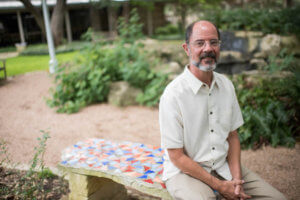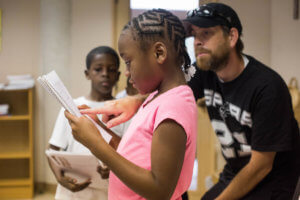

Several years ago, the Episcopalian Church of Reconciliation had a problem: Teenagers kept kicking holes in the six-foot fence surrounding the property.
In response, the church built a new fence — one that had intentional openings so people living around the church could walk onto the property. Then, they built a basketball court and a community garden to draw in even more people.
That basketball court saved Frederick Jones’ life.
“I definitely did have a lot of anger growing up,” said Jones, 17, who grew up with his grandmother in a townhome by the church.
From a young age, Jones saw overt acts of racism both on the news and in person. In elementary school, a teacher from a different school called him the “N” word.
As Jones’ anger festered, he began observing the boys and men in his neighborhood who were involved with gangs. Around the same time, he also discovered the basketball court at the Church of Reconciliation.
“The basketball court kept me out of trouble,” Jones said. “Those older guys (on the court), maybe they weren’t the best guys, but they sure enough showed me a lot of love and taught me right from wrong. They were good influences on me.”
Jones is 6 feet 4 inches tall, articulate and quick to laugh. He is the starting left tackle on MacArthur High School’s varsity football team — and has already received a wealth of scholarship offers from universities with top tier football teams. He dreams of playing in the National Football League and of using his platform to call attention to racial issues in the country. This summer, he is helping the church with one of their community outreach programs.
Learning to love your neighbor
The Church of Reconciliation is located on Starcrest Drive just outside Loop 410. It is surrounded within a half-mile by both million-dollar homes and low-income apartments. Many of the people living in the area are Hispanic or black — unlike the congregation, which is primarily white and wealthy.
If San Antonio has the most extreme economic gap in the country, as multiple studies show, the Church of Reconciliation exists right in the middle of that gap.
The church has always been inclusive when other churches weren’t — it was quick to welcome LGBTQ couples, divorcees and Alcohol Anonymous groups. Yet, over the years, it had become a wealthy church whose congregants commuted in every Sunday. The church wasn’t doing much to get to know, or help, its neighbors.
“Our church is typical Episcopalian, white middle- and upper-middle class,” Robert Woody, rector of the Episcopalian Church of Reconciliation said. “What we are trying to recognize is that we are in a neighborhood where there is a lot of diversity and a large part of the population needs help to stabilize.”

Pastor Robert Woody, sits in the courtyard garden at the Church of Reconciliation where he has been the pastor 15 years. The church is working to help their culturally and economically diverse community. Wendi Poole / Special to Folo
In 2009, a jogger was raped on the church’s campus. Around the same time, another woman was raped at one of the apartment complexes down the street.
Woody knew the community needed help stabilizing, and that the church needed to step up.
He invited representatives from the surrounding neighborhoods to meet. Eventually, the meeting led to the formation of a group called the Neighborhood Coalition, which would focus on helping the surrounding communities unite and find ways to improve safety.
At the same time, Woody and the rest of the church leadership began talking with the Reconciliation congregation about how they might attempt, well, social and racial reconciliation. They found many members shared their desire to become more involved — though, as a result of the efforts, a few people left the congregation.
Passionate members of the congregation formed a nonprofit designed to help the neighborhood called Barrington Neighbors, named after a street that runs next to the church.
The same group of congregants advocated opening the campus and building the basketball court, community garden and walking trails.
“If we don’t give back, we get spiritually constipated”
For five weeks during the summer, a diverse group of children run through the church’s campus, laughing, learning and playing. They represent a much different group than those that show up on Sundays to worship — both economically and racially.
These children from Serna Elementary School participate in what is perhaps the church’s most successful program — the Serna Summer Enrichment Program.
Six years ago, Woody was approached by the school’s principal after a Neighborhood Coalition meeting who asked if the church would be willing to host a summer camp for children who hadn’t failed but were in danger of falling behind academically.
Woody agreed. For the past six years, the church, and now Barrington Neighbors, has been raising $25,000-$30,000 annually to run the Serna Summer Enrichment Program. They hire teachers from the school. The kids learn in the morning, eat lunch provided by the San Antonio Food Bank, and play in the afternoon.

Trinity Gilchrist, 8, center, reads a story she wrote while her teacher, Jason Harrison, right, helps her during class on Thursday, June 22, 2017. The students are part of The Serna Summer Enrichment Progam at The Church of Reconciliation in North East San Antonio, Texas.
The program has been so successful that when Serna Elementary School received a district award for having the most improved test scores, the principal sent the Church of Reconciliation a letter attributing much of the success to its program.
“Some of the poorest people I know are some of the wealthiest people I know,” said Art Ramseur, who has been a member of the church for at least 25 years. “They’re poor in spirit. They’ve made a lot of money. They’re my age, and they’re fossilized. They don’t have a purpose in life anymore.”
To Ramseur, the church is not doing its job if it just preaches about helping the poor — it needs to reach in the community and break down socioeconomic and racial barriers.
Ramseur doesn’t think the church is unique because a group of white, politically conservative, wealthy individuals, like himself, are helping a poor, diverse neighborhood — he said he does that on his own. What is powerful about the church for him is it’s ability to connect the community.
“We’ve been freely given, so we give,” Ramseur said. “If we don’t give back, we get spiritually constipated.”
“What that’s done has given us back more than we give away,” Ramseur said.
Ramseur has always been involved with the church’s various tutoring and outreach programs. Now, he tutors children from Serna Elementary and is a passionate fundraiser for the Serna Summer Enrichment Program.
“I get to see the glint in the eyes that comes on when they understand they can do this, and somebody is interested in the fact that they can do it,” Ramseur says.
Looking toward the future
It’s been almost 10 years since the church opened its arms to its neighbors. However, despite all of its efforts, a divide remains between the church and those same neighbors, says Frederick Jones.
Jones explains that the chasm between the congregation and many of its neighbors is because of their backgrounds. Unlike the congregation, many of Jones’ neighbors struggle financially, they deal with racism, and their lives have been affected by crime. They don’t always know how to respond to someone like Rev. Woody.
“The court is pretty much filled with minorities, so when we are out there, those of my friends who don’t know (Woody and other church officials) … kind of retreat into a shell of ‘here comes the white people,’” Jones said.
Knowing there’s so much more ground to cover, the church wants to build a community center. Jones has pledged his help. The center will help the community, but both Jones and Woody hope it will also help the neighbors feel more welcomed by the church.
“We came up with a design plan, but we had a epiphany,” Woody said. “We were just assuming we knew what the neighborhood needed or wanted, and we hadn’t really gone out and listened to the neighborhood.”
Plans to construct the center are on hold for now. The church is conducting a listening project — a community-wide survey — of the surrounding area to find out what the neighbors actually want in the community center.
Church members realized that they couldn’t just assume they knew what was best for the community, which Woody called a big step in overcoming “white privilege.”

The Serna Summer Enrichment Progam is held at The Church of Reconciliation in North East San Antonio, Texas. The church is working with their diverse neighborhood to help their whole community. Wendi Poole / Special to Folo
The model they are using is called Asset Based Community Development (ABCD) — instead of just throwing resources at the community, they are assessing what the community wants and what skills are already there.
“We don’t want to take the approach of ‘Hey, what (are) the problems?’ so we can fix them,’” Jones said. “We want to know what they really want and bring out their inner hopes and dreams for their community and their kids, not just put something out there that people can go to, but something that they can connect to.”
This summer has been a busy one for Jones, who has to squeeze in volunteering around a busy football combine schedule.
Jones, a senior at MacArthur, hopes there will be an indoor basketball court and a mentoring program at the center so children in the neighborhood can get the same help he did.
“I know guys now that are going off to college,” Jones said. “They are doing great. They’re better people. They’ve learned better life skills and…that court has been a big part of that.”
This article was originally published by the H.E. Butt Foundation’s Folo Media initiative in 2017.